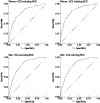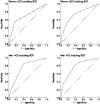Danish singles have a twofold risk of acute coronary syndrome: data from a cohort of 138 290 persons
- PMID: 16840763
- PMCID: PMC2588084
- DOI: 10.1136/jech.2005.041541
Danish singles have a twofold risk of acute coronary syndrome: data from a cohort of 138 290 persons
Abstract
Study objective: Atherosclerosis of the coronary and other arteries is an important health problem in virtually all countries of the world, and thus there is a persisting need for the development of preventive programmes including population risk group identification. The aim of the study was to identify sociodemographic population risk indicators of an initial episode of acute coronary syndrome (ACS), including unstable angina pectoris (UAP), myocardial infarction (MI), and sudden cardiac death (SCD).
Design: Cohort study of 138 290 residents of the municipality of Aarhus, Denmark, aged 30-69 years. Information on population members' individual age, sex, social background, and eventual death was obtained from Danish Population Registers.
Setting: University hospital.
Patients: The study prospectively identified 646 victims of ACS from 1 April 2000 to 31 March 2002.
Main results: Based on multiple logistic regression, age and single living were found to be positively associated with incident ACS in both sexes. Women >60 years living alone and men >50 years living alone were at especially high risk. They constituted only 5.4% and 7.7% of the source population, respectively, but they accounted for 34.3% and 62.4% of ACS patients dying within 30 days.
Conclusions: Single living is associated with an increased risk of ACS. Thus, risk groups identified by use of information on their age and family structure may be targets for future more focused and cost effective preventive strategies. In Western populations, such high risk groups will constitute comparatively limited parts of the population, and in Denmark they are easily identifiable in routine population registers.
Conflict of interest statement
Conflicts of interest: none declared.
References
-
- Beaglehole R. International trends in coronary heart disease mortality and incidence rates. J Cardiovasc Risk 1999663–68. - PubMed
-
- Tunstall‐Pedoe H, Kuulasmaa K, Mahonen M.et al Contribution of trends in survival and coronary‐event rates to changes in coronary heart disease mortality: 10‐year results from 37 WHO MONICA project populations. Monitoring trends and determinants in cardiovascular disease. Lancet 19993531547–1557. - PubMed
Publication types
MeSH terms
LinkOut - more resources
Full Text Sources
Miscellaneous



